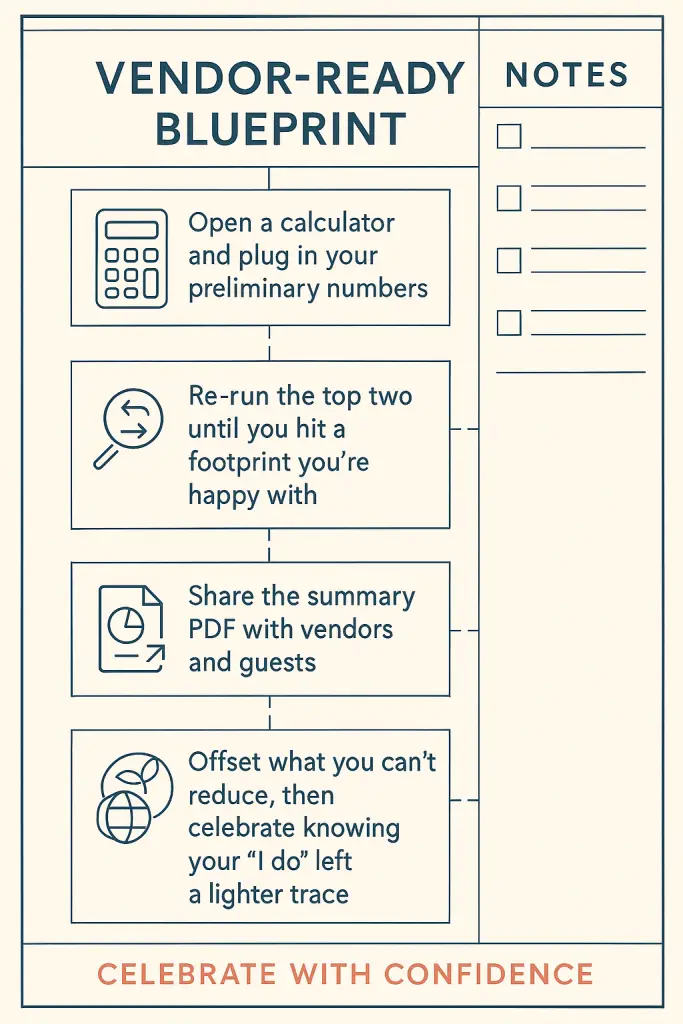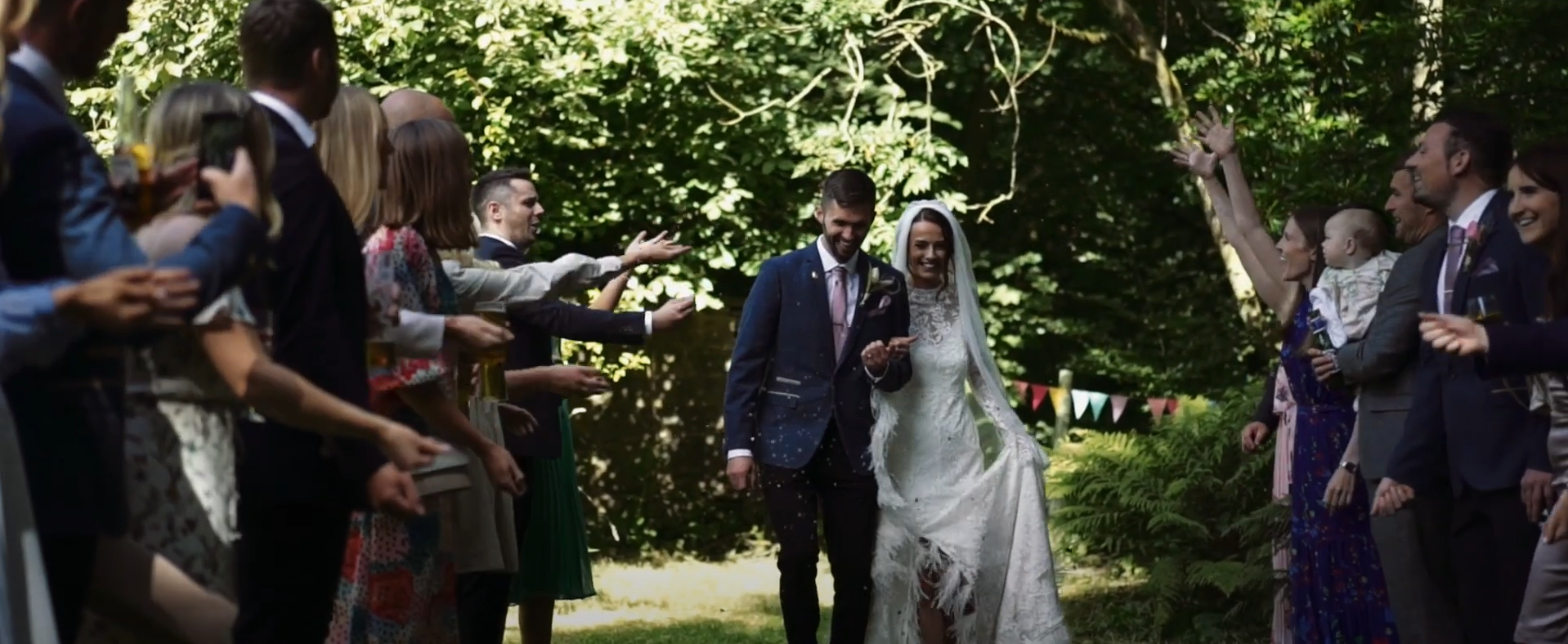Why Your Wedding’s Carbon Number Matters
Researchers estimate the typical U S wedding produces about 400 lb (181 kg) of waste and roughly 63 metric tons of CO₂‑equivalent emissions—more than the yearly footprint of five average people combined.
Those numbers are eye‑opening, but they are also actionable: once you know where the tonnes come from, you can shrink them.
What a Wedding Carbon Calculator Actually Does
Event‑specific calculators translate every planning choice—guest travel, menu, energy, flowers, even dress fabric—into a single, comparable metric: kilograms or tons of CO₂e.
From @opinion: Weddings are getting more expensive. But what’s not being talked about is the cost on the environment. @lararhiannonw analyzed everything from the dress to the flights: Take our carbon footprint quiz to see how it adds up.
🔗💐💍: https://t.co/LSVfA0Ry7s pic.twitter.com/1AOfdo1prO
— Bloomberg Graphics (@BBGVisualData) June 23, 2024
Leading tools include the free, questionnaire‑style Wedding Footprint Calculator from Mindfully Wed, the professional‑grade myclimate Event Calculator, and the mobile‑friendly Sustainable Wedding Alliance Carbon Calculator.
Each uses lifecycle‑assessment databases and prompts tailored to weddings so you can model different scenarios in minutes.
First Click, Big Picture
Start by entering the estimated guest count and where everyone is coming from—travel is almost always the largest slice of the pie.
Next add venue energy use, catering style and décor plans. Most calculators show live bar charts, so as you toggle from, say, a beef‑heavy plated dinner to a vegetarian buffet, the footprint visibly drops.
Seeing the impact in real time makes trade‑offs concrete instead of abstract.
Target the Hotspots
Travel and Accommodation
Choose a venue within driving or public‑transit distance for most guests, or provide group shuttles. Hybrid celebrations—livestreaming for long‑haul invitees—slash air‑travel emissions without cutting anyone out.
Food and Drink
Seasonal, plant‑forward menus can shave up to 60 percent off the catering footprint. Ask caterers to source locally and compost prep scraps; most calculators let you model these switches instantly.

Fashion and Décor
Buying a sample or vintage gown, renting suits and repurposing florals reduces the embodied carbon of “stuff.” The Guardian’s low‑waste case study saw trash drop from the U S average of 400 lb to just 35 lb by thrifting glassware and up‑cycling vases.
Energy
Outdoor daytime ceremonies need little lighting. For indoor receptions, request renewable‑energy credits from the venue or bring in LED fixtures.
From Calculating to Offsetting
After you’ve trimmed emissions, calculators such as Terrapass’s Wedding Offset Tool or myclimate’s checkout page convert the remainder into a dollar figure to fund verified wind, solar or re‑forestation projects.
Tip: look for offsets certified by Gold Standard or Clean Development Mechanism, and ask the provider for project details you can share with guests.
Looping In Vendors and Guests
Send your footprint results to caterers, florists and rental companies so they see sustainability is a priority.
Some couples publish a short note on their wedding website explaining the calculator they used and inviting guests to car‑pool or buy a rail ticket instead of flying. The transparency tends to boost participation and goodwill.
Digital‑First Planning
Your wedding deserves more than just paper invites! 🌸 A personalized wedding website is the perfect way to share your story, organize events, collect RSVPs, and keep guests in the loop — all in one place. 💌📆
🎯 This blog covers:
✔️ Step-by-step guide to building a stunning… pic.twitter.com/X9SBgjukV9
— Cyber Infrastructure, "CIS" (@cisin) May 2, 2025
Using online RSVPs, e‑schedules and QR‑code seating charts saves paper and ink—and the calculators capture those savings when you tick the “digital stationery” option. Even small reductions (a 200‑person invitation suite can weigh 10 kg) add up.
Looking Ahead
Sustainability consultancies report a 300‑percent jump in couples running emission models since 2023, and industry bodies predict carbon labelling could become as common as cost estimates within five years.
Platforms such as Mindfully Wed and the Sustainable Wedding Alliance are already aggregating anonymized data so vendors can benchmark their services against national medians.
Your Action Plan in One Sitting
Begin by opening your preferred carbon calculator and plugging in your preliminary numbers to establish a baseline.

Identify the two largest emission sources—often travel and catering—and brainstorm lower‑impact alternatives such as choosing a venue closer to most guests, serving a plant‑forward menu, or selecting second‑hand attire.
Each time you adjust a detail, re‑run the model until the footprint aligns with your goals. When you land on a scenario that feels right, export the calculator’s summary PDF and share it with vendors and guests so everyone understands the sustainability priorities.
Finally, offset any remaining emissions through a reputable provider and step into your celebration confident that your “I do” leaves the lightest possible trace.
Wrapping Up
Carbon calculators turn eco‑anxiety into a design brief: fewer miles, smarter materials, unforgettable memories. With these tools at your fingertips, planning a low‑footprint wedding is no longer a niche ambition—it’s simply good wedding planning.

